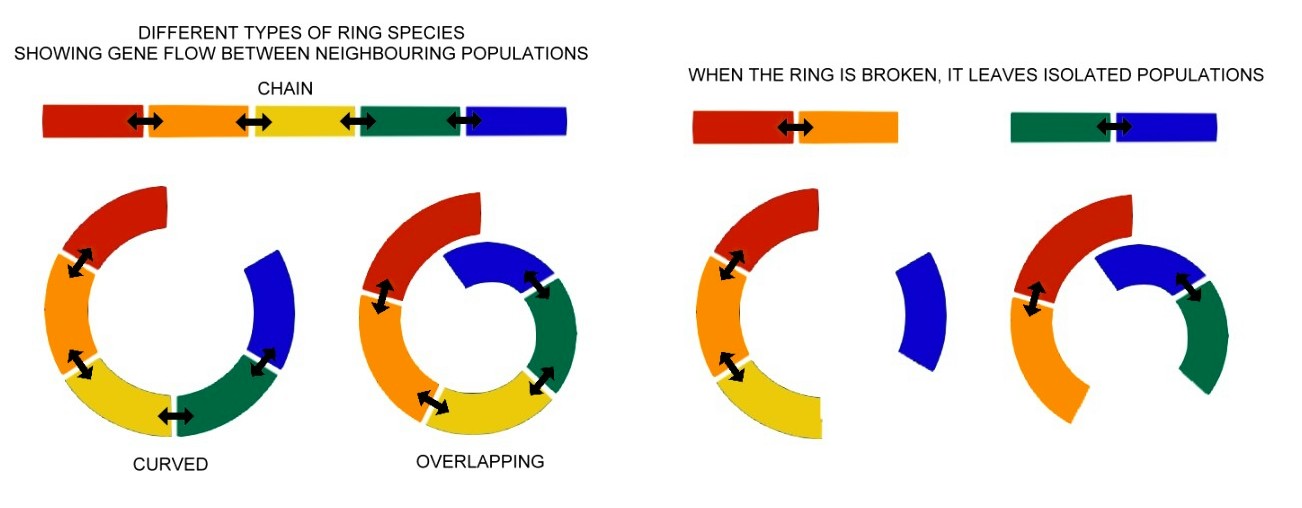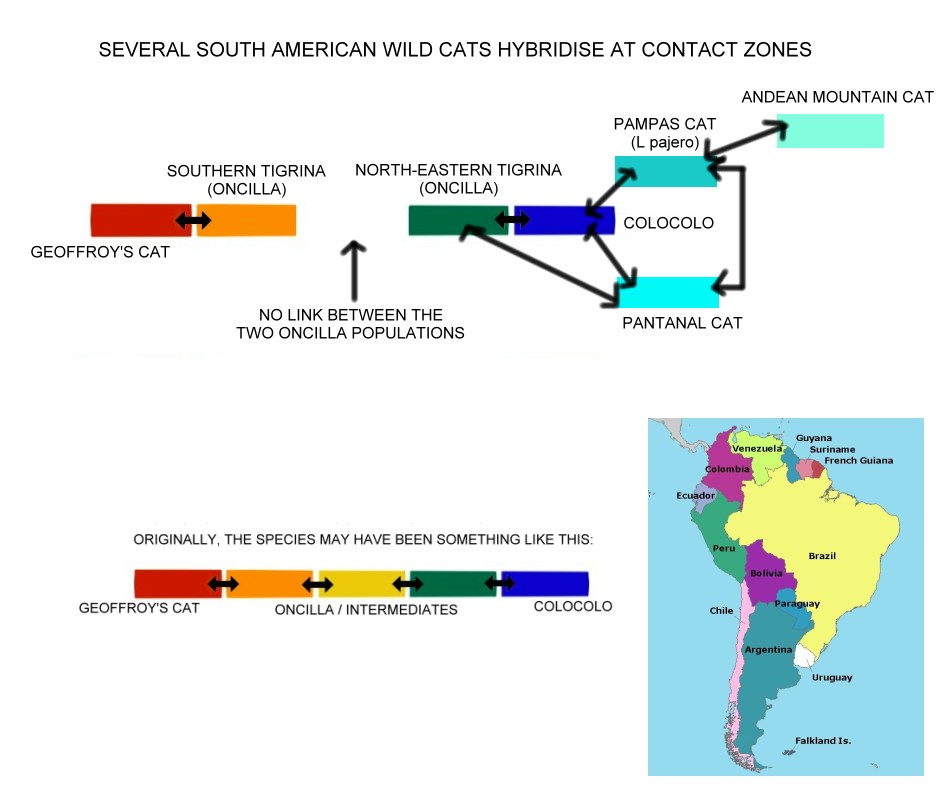
|
HYBRIDISATION IN SOUTH AMERICAN WILDCATS |
"Species" is a human concept mostly based on visual appearance, geographic separation and inability to produce viable or fertile offspring. Nature doesn't observe such strict boundaries and species aren't stable entities - they can both split and recombine as their habitat changes. Species are also split into sub-species by taxonomists; sub-species can interbreed but are usually prevented from doing so by geographical separation. As genetic studies continue, species can be demoted to sub-species and sub-species can be elevated to full species. And sometimes researchers reach opposing conclusions as studies continue.
A cryptic species complex comprises a group of (usually) closely related species whose precise classification and relationship to each other can't be easily determined without detailed genetic studies.
A ring species is a connected series of neighbouring populations. Each population can interbreed with its nearest neighbours, but the "end populations" are too distantly related to interbreed with each other. Genes can flow along the ring via the intermediate populations. The ring can be broken e.g. by geographical changes, preventing gene flow.
In the diagrams, each coloured bar represents a natural populations varying along a cline (a gradual change in conditions which gives rise to slightly different characteristics predominating in the organisms that live along it). Although called a ring species, it may actually be a straight line (e.g. from a wetland species to an arid environment species); it may curve around an obstacle such as a shoreline, and it may even bend around completely so that the two endpoints overlap but are different enough that they cannot interbreed.

The small wild cats of South America (the Leopardus genus) continue to present problems in distinguishing the species. Studies indicate that these wildcats evolved very quickly to fill the various ecological niches when North America and South America became joined together by the Panama land bridge. Speciation may be incomplete in some cases, while in others there are stable hybrid zones. They are genetically closely related and many of the species interbreed naturally where their ranges overlaps. Others, normally separated by geography, will interbreed in captivity.
Over the years, genetic studies indicated that genus Leopardus is a distinct clade within the feline subfamily. It evolved in South America around 10-12 twelve million years ago and contains 2 distinct evolutionary lineages. One lineage led to the Ocelot, Margay, and Andean Mountain Cat. The remaining species came from the second lineage. There was a major split around 5-6 million years ago, creating 3 groups. The earliest divergence led to the Oncilla (tigrina), followed by a split that led to the ancestor the Kodkod, Colocolo and Geoffroy's Cat. Finally the common ancestor of the Ocelot and Margay split off. [Ref 1]. The Colocolo subsequently split into 3 species around 1.7 million years ago though the exact relationship between the Colocolo, Pampas Cat and Pantanal Cat is still contested.
The species and dates of recognition are:
Leopardus braccatus (1889) - Pantanal Cat, sometimes considered part of F colocolo
Leopardus colocolo (1782) - Colocolo, formerly Oncifelis colocolo. Called the Pampas Cat by those who don't recognise the F braccatus and F pajero as distinct species.
Leopardus geoffroyi (1844) - Geoffroy's cat, formerly Oncifelis Geoffroyi
Leopardus guigna (1782) - Kodkod, formerly Oncifelis guigna
Leopardus guttulus (2013) - Southern Oncilla/Tigrina
Leopardus jacobitus (1865) - Andean Mountain Cat
Leopardus pajeros (1816) - Pampas Cat
Leopardus pardalis (1758) - Ocelot
Leopardus tigrinus (1775) - North-eastern Oncilla/Tigrina, Little Spotted Cat
Leopardus wiedii (1821) - Margay (formerly the Tree Ocelot)
In 2013, researchers confirmed that the South American Oncilla (Leopardus tigrina, also known as the Tiger Cat or Tigrina) was not a single species, but was two genetically distinct populations that did not interbreed.
Eduardo Eizirik (Pontifícia Universidade Católica do Rio Grande do Sul) and his co-researchers weren't looking for a new species. They were investigating the evolutionary history of 3 species in the genus Leopardus. These 3 species were:
Colocolo (L colocolo): a heavy-set, long-haired cat about the size of a large house cat, but with a shorter tail. It has several subspecies, some of which have ticked coats and others have rosetted markings. It inhabits grasslands and scrublands on the west Andean slopes of northern Chile. Some authorities lump the Colocolo, Pampas Cat (L pajero) and Pantanal Cat together as a single species called the Pampas Cat as these are genetically very closely related and can interbreed.
Geoffroy's cat (L geoffroyi): a spotted cat similar size to the Colocolo cat. It inhabits scrubland throughout Argentina.
Oncilla or Tigrina (Leopardus tigrinus): found throughout much of Central and South America. A spotted cat similar in size to a house cat. The 4 sub-populations included the southern tigrina from Brazil's mountainous forests, and the north-eastern tigrina, which lives in savannahs and grasslands. The north-eastern tigrina has a lighter coat with slightly smaller rosettes than the southern tigrina.
DNA samples were analysed from 216 individuals of those 3 species across their ranges. Mitochondrial DNA (inherited from the mother only) revealed evidence of ancient interbreeding and introgression (hybrid offspring interbreeding with one or other parent species) between the Colocolo and the north-eastern tigrina. This meant the 2 species had frequently interbred before splitting into separate species. [Ref 2]
Meanwhile, the Geoffroy's cat and the southern tigrina had split into separate species over a million years ago. DNA analysis found evidence of recent and regular interbreeding in parts of southern Brazil and Bolivia where their habitats overlap. Away from that boundary area, the 2 species remain distinct. [Ref 2], [Ref 3]
A bigger surprise was that the 2 tigrina populations were not interbreeding. That meant they were effectively different species with no gene flow between them. They were as distinct from each other as the Geoffroy's cat is genetically distinct from the Colocolo. While the north-eastern tigrina stays as L. tigrinus, the southern tigrina has become L. guttulus and there is very little known about its ecology. [Ref 2]

The rare Andean Mountain Cat, most easily described as the size and colour of a tabby house-cat and the shape of a Snow Leopard, inhabits the high Andes regions of Peru, Bolivia, Chile and Argentina. Parts of its range overlap with the Pampas Cat (L pajero) and they compete for the same main prey in their diets. It is frequently difficult to visually distinguish between the two species, and because of the overlap, they hybridise.
The Pantanal Cat inhabits areas of Brazil, Uruguay, Bolivia, Paraguay and Argentina. Its habitat includes grassland and dense forest as well as the Pantanal wetlands. It's exact taxonomy is uncertain - it may be a distinct species or it may be a subspecies of the Colocolo. The interbreeding between several of the South America small cats suggests that speciation is incomplete! In Brazil, it hybridises with the Oncilla (tigrina).
The Pampas Cat (L. pajero) inhabits Argentina, Chile, Peru, Bolivia and Ecuador and may extend into south-western Columbia. It is found in grassland, shrubland and dry forest and its range extends into the Andes where it interbreeds with the Andean Mountain Cat.
In the 1950s and 1960s, Margays and Ocelots became popular exotic pets in the USA, but were so similar-looking that many owners didn't know whether they had a "Tree Ocelot" (Margay) or a "True Ocelot". Having already bred bobcat-ocelot hybrids, Ginny Story set out to breed margay-ocelot hybrids (Marlots) [Ref 4] In 1976, Barbara Brock announced the birth of a male Marlot sired by a "largish" domestic born margay called Macho on a female "small" domestic born ocelot called Cha-Cha. The hybrid offspring was a female called Precious. She resembled both parents. Her rosettes were darker like the margay and her coat was golden but she had the pink nose of her ocelot mother and the ocelot tail. Another Marlot, called Baby, was mentioned in 1980.
The ocelot's range extends through Central America and into North America. Ocelot-Bobcat hybrids were also being bred and it is also possible that the two species have hybridised in the wild in Texas where their ranges overlap. About 10% of live-trapped bobcats in one region had ocelot-style markings, but there have been no DNA tests (to my knowledge) to confirm hybridisation.
REFERENCES AND FURTHER READING
[Ref 1] Slattery JP, Johnson WE, Goldman D, O'Brien SJ. "Phylogenetic reconstruction of South American felids defined by protein electrophoresis." Journal of Molecular Evolution. 1994 Sep;39(3):296-305.
[Ref 2] Tatiane C. Trigo, Alexsandra Schneider, Tadeu G. de Oliveira, Livia M. Lehugeur, Leandro Silveira, Thales R.O. Freitas, Eduardo Eizirik "Molecular Data Reveal Complex Hybridization and a Cryptic Species of Neotropical Wild Cat" Current Biology, 27 November 2013
[Ref 3] E Eizirik, C Indrusiak, TC Trigo, DA Sana, FD Mazim and TRO Freitas (Autumn 2006) Refined Mapping and Characterization of the Geographic Contact Zone Between Oncilla and Geoffroy's Cat in Southern Barzil. IUCN Cat News 45: 8-11.
[Ref 4] Ginny Story, Long Island Ocelot Club (LIOC) Newsletter Aug 1973.
[Ref 5] Long Island Ocelot Club Newsletters Aug 1976 and Feb 1977.
|
BACK TO HYBRID & MUTANT BIG CATS INDEX |